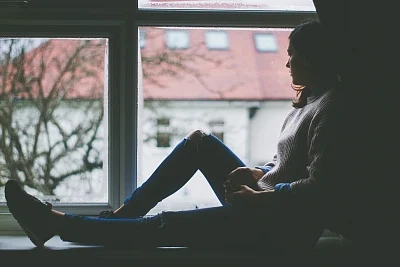Depression is an illness that affects the normal functioning of your brain and affects you emotionally as well. Depression can be so bad that it starts affecting you physically, disrupting your eating and sleeping patterns. Depression can be a reaction to something sad, the loss of someone, or dejection. At times, these feelings of sadness aggravate and become intense resulting in a medical condition called clinical depression.
There are several ways to manage the symptoms of depression like changes in your lifestyle and eating habits. You can include yoga to lighten your mood and keep depression at bay. Research has proved that yoga poses increase blood circulation to the brain thus producing mood-elevating hormones.
Yoga is better than taking medications because they do not have any adverse side effects. Thus, here are 5 yoga poses you can try at home to keep depression at bay.
1. Child's Pose
The child's pose may be helpful for your hips and back, relaxing them and allowing them to stretch. In this pose, you will have to kneel and sit on your knees.
Lean forward while keeping your buttocks on your heels, and rest your forehead on the floor. Place your arms next to your legs, palms facing up. Try to inhale and exhale slowly and deeply. Complete at least eight breaths.
If you find it difficult to rest your forehead on the floor, give this a try. Kneel and sit on your knees with your knees slightly apart. Lean forward and fold your arms in front of you on the floor. Now rest your forehead on your arms and continue inhaling and exhaling.
2. Bridge Pose
The bridge pose helps regulate blood pressure. It calms the brain and alleviates stress. It is beneficial in managing mild depression and is good for abdominal organs, lungs, menstrual pain, fatigue, headache, and anxiety as well.
Lie on your back, place your hands at your sides, bend your knees, and your feet should be flat on the floor close to your butt.
Press into your feet while you lift your hips and torso to create a straight line from your knees to your shoulders.
Hold the pose for up to 30 seconds, then lower your hips to the floor.
3. Plow Pose
Plow pose is also great for digestion and a healthy gut in turn helps maintain healthy and glowing skin naturally.
If you want to try the plow pose, follow the steps given here:
Press your arms to the floor, and lift your legs over your head towards the floor while inhaling. You will have to stretch out through the heels. Now slowly walk your shoulders towards each other while your chin is up and hands are placed on the lower back for support. Press through the arms, shoulders, and feet if they are on the floor.
4. Downward Dog Facing Pose
This is one of the traditional yoga poses in which you bend forward. It can be restful and rejuvenating. This pose can help relieve back pain and sciatica. It helps manage imbalance and improves strength.
The pose focuses on muscles like the hamstrings, deltoids, gluteus maximus, triceps, and quadriceps. You should:
Get on all fours.
Your hands should be aligned under your wrists and your knees under your hips.
Press into your hands, tuck your toes, and lift up your knees.
Move your sitting bones slowly up toward the ceiling.
Slightly bend your knees and lengthen your spine and tail bone.
Your heels should be slightly off the ground.
Press firmly into your hands and distribute the weight on both sides of the body.
Pay attention to the position of your hips and shoulders.
Your head should be in line with your upper arms and your chin tucked in slightly.
Hold this pose for at least one minute.
5. Corpse Pose
This is a traditional resting pose and helps relax the entire body without putting pressure on any specific muscle groups. It helps calm the central nervous system, aiding the digestive and immune systems. It might also help manage blood pressure and frequent headaches.
Lie down on your back and open up your arms and legs. Then turn your palms upward.
After you get into this position, relax your whole body and face. Don't try to hold your position; try to feel heavy instead.
Try breathing naturally.
Try staying in this position for as long as you are comfortable.
When you want to come out of the pose, deepen your breath, then start to wiggle your fingers and toes to reawaken your body.
Make sure to do a full-body stretch from hands to feet.
Close your eyes and bring your knees to your chest and roll over to one side. Rest in the fetal position for a few breaths.
Return to a sitting position with the help of your hands.
(At The Quint, we question everything. Play an active role in shaping our journalism by becoming a member today.)
